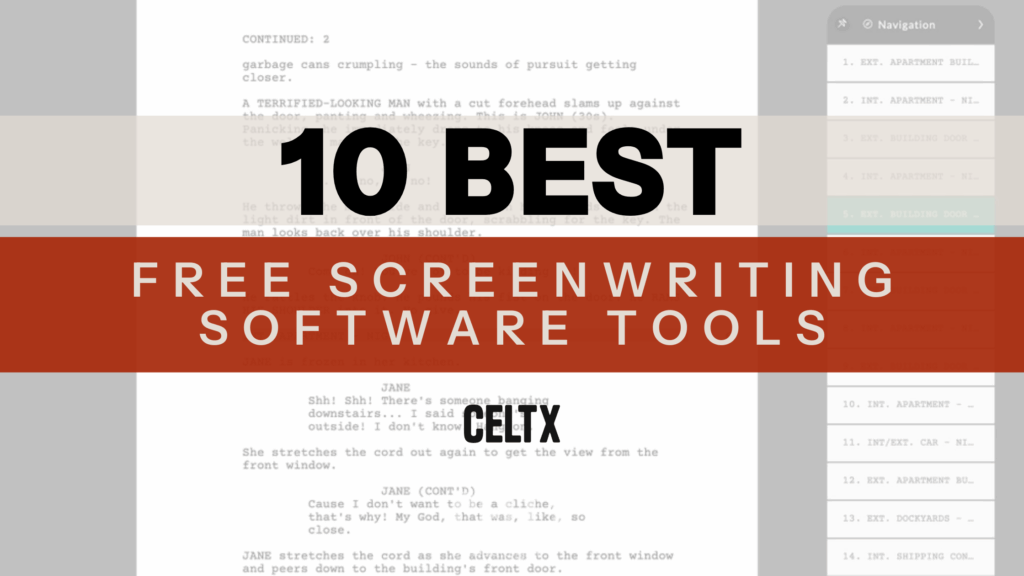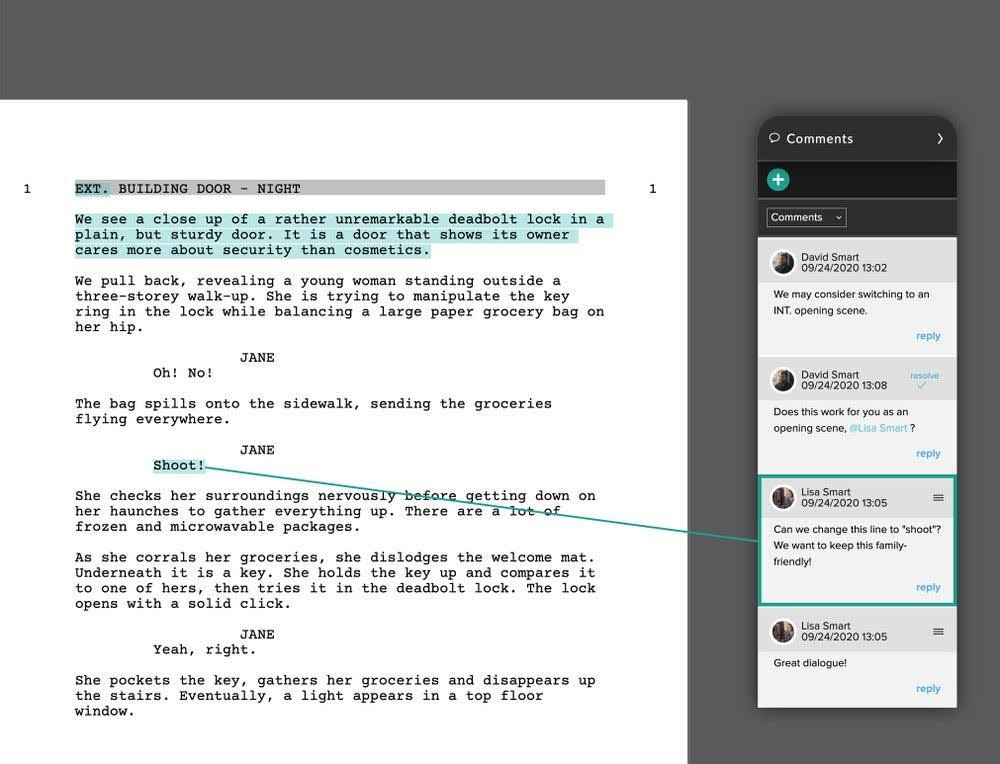
Writing a screenplay is an art, but it’s also a craft with strict formatting rules.
If you’re serious about screenwriting, you’ll quickly discover that standard word processors like Microsoft Word or Google Docs just won’t cut it. While it is possible (and extremely fiddly) to write a script in Google Docs, word processors like this just aren’t designed to automatically format scene headings, dialogue, parentheticals, or action descriptions to industry standards. That’s where screenwriting software comes in!
Writing a screenplay, for me, is like juggling. It’s like, how many balls can you get in the air at once? All those ideas have to float out there to a certain point, and then they’ll crystallize into a pattern. – James Cameron
But don’t worry because there’s good news! You don’t need to spend hundreds of dollars on Final Draft or similar programs to get started. Today, there are plenty of free screenwriting software tools that deliver professional-quality formatting, collaboration features, and cloud syncing: all without breaking the bank.
It doesn’t matter whether you’re writing your first short film, starting film school, or a writer aiming to enter contests, free screenwriting tools can give you the foundation you need.

And in today’s blog, we’ll be revealing the 10 best free screenwriting software tools, explore what to look for when choosing one, and help you decide which one is best for you and your workflow.
So, without further ado…
Table of Contents
- Why Use Free Screenwriting Software?
- What to Look for in a Free Option
- The 10 Best Free Screenwriting Software
- Celtx Free vs Paid Plans
- Which Tool Is Right for You?
- FAQ
- Conclusion
Why Use Free Screenwriting Software?
Free screenwriting software definitely has a place among its paid counterparts. But what is that place and why should you consider a free tool if you’re in the market for a new one.
Here are six reasons why:
1. Budget Friendly
Not everyone can afford $200+ on a specialized software right away. Free tools give you professional formatting without upfront costs, letting you focus on writing.
2. Beginner Friendly
If you’re new to screenwriting, free tools are perfect to help you learn the basics without the pressure of a financial commitment. Many come with tutorials, templates, and intuitive layouts.
3. Professional Standards
Good free screenwriting software ensures your script meets Hollywood formatting guidelines. This is essential if you’re submitting to agents, competitions, or production companies.
So, what are these ‘Hollywood formatting guidelines’? Luckily, we have a blog explaining all: How to Format a Script.
4. Collaboration
Many modern free tools include real-time collaboration, letting co-writers, directors, or producers contribute directly to your project.

5. Accessibility and Flexibility
Free screenwriting software is often cloud-based, meaning you can write from a laptop, tablet, or even a phone. Others are offline-friendly if you prefer distraction-free desktop writing.
6. Upgrade Path
Most free tools have premium versions. You can start small, and as your projects grow, upgrade to unlock advanced features like production scheduling, revision tracking, or team management.
What to Look for in a Free Option
While many of the free options are accessible and workable, not all are created equally. Of course, it wholly depends on your priorities as a writer, but we recommend you make sure to pay attention to the following:
Formatting Automation
Does the software auto-format scene headings, action, dialogue, and parentheticals?
Export Options
Can you export your script to PDF, .fdx (Final Draft), or Word?
Ease of Use
Does the interface make writing intuitive?
Collaboration
For writing teams, does it allow multiple users to write and provide feedback in real time?
Cross-Platform Support
Is the software available for Windows, Mac, Linux, iOS, and Android?
Cloud Storage
Is your work synced and backed up so you can keep track of different versions and revisions?

Community and Support
Are there tutorials, forums, or help guides available if you need support with the software features?
With those factors in mind, let’s dive into the ten best free screenwriting tools out there.
The right tools can make writing easier—but the right software can transform your entire process. Try Celtx free today and see how much smoother your scriptwriting can be.
Start writing with Celtx
The 10 Best Free Screenwriting Software
1. Celtx (Free Plan)
| Free Features | Pros | Cons |
| One project limit | Intuitive, beginner-friendly | Only one project in the free plan |
| Browser-based writing with auto-formatting | Cloud-based, accessible from anywhere | Collaboration, storyboarding, and scheduling locked behind paid plans |
| PDF export | Supports film, TV stage plays, and audio scripts |
Later on, we’ll be diving a little bit deeper into what we can offer you at Celtx. We’ll even give you a sneak peek into our paid plan and why you should consider it.
But for now, let’s get back to our list!
2. WriterDuet (Free Tier)
| Free Features | Pros | Cons |
| Up to three free projects | Ideal for co-writing and live editing | Only three projects unless you pay |
| Real-time collaboration | Modern, user-friendly interface | Some export formats require the premium tier |
| Imports/exports Final Draft files | Secure cloud backups |
Check out WriterDuet here.
3. Trelby
| Free Features | Pros | Cons |
| 100% free and open-source desktop app | Completely free with no hidden paywalls | Not cloud-based |
| Available on Windows and Linux | Fast and lightweight | Outdated UI compared to newer apps |
| Unlimited scripts | Full industry-standard formatting | No mobile or Mac support |
If Trelby sounds your vibe, click here to explore it in more detail.
4. Highland 2 (Free Version)
| Free Features | Pros | Cons |
| Available for Mac only | Clean distraction-free design | Mac-exclusive |
| Basic screenplay formatting | “Fountain” plain text format compatibility | Watermark on free exports |
| Exports to PDF | Minimalist and great for focus | Some features are locked behind paid version |
Sound good? Find out more about Highland 2 here.
5. Arc Studio Free
| Free Features | Pros | Cons |
| Two free scripts | Sleek, modern design | Only two projects on free plan |
| Real-time collaboration | Great for collaboration | Offline mode requires upgrade |
| Cloud syncing | Industry-standard formatting |
Check out Arc Studio here.
6. StudioBinder (Free Tier)
| Free Features | Pros | Cons |
| Cloud-based script editor | All-in-one solution (script and production) | Some production tools locked behind premium |
| Unlimited projects with basic tools | Cloud-based, accessible anywhere | Can feel overwhelming for beginners |
| Integrates with production management tools | Free version generous for scriptwriting |
Fancy giving StudioBinder a closer look? Click here for more.
7. Fade In (Demo)
| Free Features | Pros | Cons |
| Free demo with full features (watermarked) | Industry-favorite alternative to Final Draft | Free version watermarked exports |
| Unlimited scripts | Professional-grade features | Better suited for serious writers |
| Cross-platform (Windows, Linux, Mac) | Affordable upgrade path |
Discover Fade In here.
8. Kit Scenarist
| Free Features | Pros | Cons |
| Open-source, cross-platform | Very powerful and customizable | Steep learning curve |
| Full-featured scriptwriting | Supports multiple languages | UI less polished than paid apps |
| Research and planning tools | Free forever |
Does Kit Scenarist sound like the software for you? Find out more here.
9. Squibler (Free Plan)
| Free Features | Pros | Cons |
| Unlimited documents in free plan | Modern, distraction-free writing environment | Advanced collaboration and exporting require premium |
| Basic screenwriting templates (film, TV, stage) | Supports multiple formats (novels, screenplays, articles) | Not as widely used in Hollywood as Celtx or Final Draft |
| Cloud-based editor with auto-formatting | Generous free plan compared to others |
Discover Squibler here.
10. Scrite
| Free Features | Pros | Cons |
| Desktop software for Windows, Mac, Linux | Great for writers who like to visualize structure | Newer software with smaller community |
| Unlimited scripts | Built-in index cards for scene planning | Occasional stability issues |
| Story structure tools | Free with no project limits |
If Scrite sounds like the software for you, click here.
Celtx Free vs Paid Plans
Ok, now let’s focus on the cream of the crop when it comes to free screenwriting software: Celtx! We’re one of the most recognizable names in screenwriting software, and for good reason!

While our free software option is perfect to get you started, our affordable paid plan offers some awesome extra features, ideal for both scriptwriting and pre-production.
Here’s how it stacks up:
Celtx Free
- One project limit
- Scriptwriting only
- Basic PDF export
Celtx Paid (from $15 per month)
- Unlimited projects
- Collaboration tools (invite team members)
- Storyboarding, shot lists, and index cards
- Budgeting and scheduling tools for production
- Cloud storage and revision tracking
So, what’s the verdict? Well, as we mentioned, if you’re just starting out, Celtx Free is great for experimenting with one script. But if you’re moving into professional projects, especially with collaborators, the paid plan quickly becomes necessary.
Find out more about Celtx’s paid plan right here.
Which Free Screenwriting Tool Is Right for You?
Of course, not all software will be right for every writer. Here are our recommendations depending on what your vibe is.
| Solo Beginner Writers | Collaborators/Co-Writers | Mac Users | Professional Polish | Open-Source Fans | Production-Minded Teams |
| Trelby | WriterDuet | Highland 2 | Celtx | Kit Scenarist | Celtx Pro |
| Scrite | Arc Studio | Fade In | Trelby | StudioBinder | |
| Highland 2 |
If you still can’t decide, consider your workflow. Do you just want a free, distraction-free writing space? Or do you need collaboration and production planning?

Once you answer these questions, it’ll soon become clear which software is the one for you.
If you find yourself still searching for the right fit (and price point is not the only thing you’re basing your decision on), check out our run down on choosing a software based on your own personal writing style and needs here!
FAQ
Many free tools (WriterDuet, Fade In, Arc Studio) support .fdx exports, but some restrict to premium tiers.
Yes, absolutely. As long as your script is formatted correctly, it doesn’t matter what software you used.
Trelby, Kit Scenarist, Scrite, and Fade In can work offline. WriterDuet and Arc Studio require online use unless upgraded.
Final Draft, WriterDuet and Celtx offer mobile-friendly versions of their software. Others are desktop only.
Definitely! Most free tools offer seamless upgrade options, so you don’t lose your projects in the process.

Conclusion
The best screenwriting software is the one that helps you actually finish your script. Free tools today are powerful, accessible, and beginner-friendly, so you don’t need Final Draft to start writing. If you’re a beginner, try Trelby or Scrite. If collaboration is key, check out WriterDuet or Arc Studio. And if you plan to eventually move into production, Celtx or StudioBinder might be your best long-term bet.
What matters most is not which tool you choose, but that you sit down and start writing. The right software will fade into the background while your story takes center stage.
Don’t just collect tools—use them to bring your story to life. Start your free trial of Celtx today and take your script from first draft to production-ready.
Start Your Free Trial
You May Also Like:
- How to Write a Short Film Script (Free Template) – Step-by-step guide plus a downloadable template.
- How to Write a Movie Script – Practical advice on story, structure, and pacing.
- Screenplay Format: The Complete Guide – Industry-standard formatting rules every writer needs to know.
